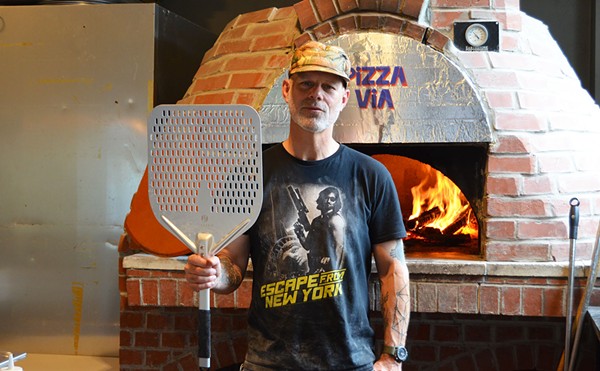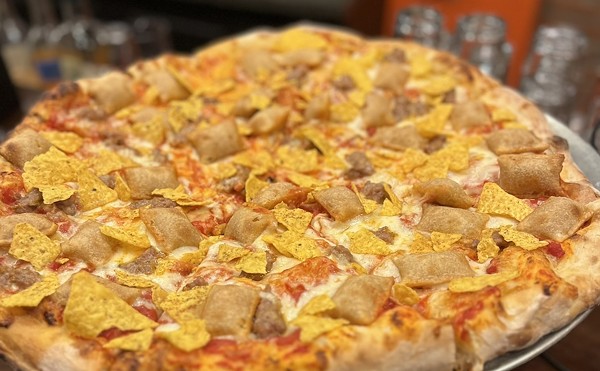Exceptions do surface — the 1961 Latour, the career of Rickey Henderson. But how does a restaurant achieve that kind of longevity?
"Herbie always said to find as many new products as you can, to be a pioneer." Flynn recalled that Balaban's was the first local restaurant to bring in West Coast oysters, to grill with mesquite charcoal and to introduce seafood from Hawaii.
— From a review of Café Balaban in the St. Louis Post-Dispatch, August 20, 1998
Herb (a.k.a. Herbie) Balaban opened his namesake café in the Central West End in 1972. Some things about the place haven't changed since. The beef Wellington and the cucumber bisque, for example remain steadfast after 30-plus years. And why not? Restaurants of a certain age have license to transcend — or pay no attention to — fad-chasing. Besides, ain't nothing wrong with a good beef Wellington or cucumber bisque.
Unless you're looking for a dish so fashion-forward that you're not likely to find it anywhere else in town (yet). Take Balaban's barramundi, a saltwater species native to Australia and the centerpiece of one of the entrées chef Dan Joyce debuted on the menu with the advent of 2006. What a showstopper this baby is, a white-fleshed fillet that begs to be sautéed so that its skin can crisp up with a deliciously toasty flavor while its meat remains impossibly moist. This is a serious piece of seafood, robust and edgy and complex — anything but mild and subtle — and Joyce smartly underscores it with a sweet and simple potato hash and a lobster butter sauce. It might also be one of the few fish that could go toe to toe with a glass of Australian shiraz in confidence and bite.
The barramundi's awesomeness is only part of its presence on Balaban's menu. It's there, too, as a bellwether, a signal that the chef doesn't fear evolution and is committed to keeping his kitchen invigorated. Café Balaban walks a fine line of past-present-future cuisine, and right now it is doing so very, very well.
Another newly arrived menu item is veal Oscar — which, in the pantheon of culinary inventions, hearkens back to royal Sweden. Here Joyce is toying with us, bringing something centuries-old to a decades-old eatery and having fun with it as something new. It certainly comes off as fresh: brilliantly sautéed right to the brink of overdone, topped with luscious crab meat and a heady but not too heavy béarnaise and sided classically with a few firm asparagus spears.
An appetizer of seared, coriander-encrusted tuna dances nimbly on the tongue alongside sticky rice and a pleasing pile of seaweed salad. (Balaban's has long played with Asian influences, which, if the era of fusion taught us anything, can harmonize beautifully with French fare.)
[T]his one-time pacesetter, in business nearly 30 years, is resting on its laurels. ... Joyce relies on ingredients whose 15 minutes of culinary fame has expired — things such as sun-dried tomatoes, roasted portobellos, Asiago cheese and balsamic vinegar.
— From a review of Café Balaban in the Riverfront Times, January 30, 2002
About four and a half years ago, Culinary Institute of America alum Joyce took over the reins in Balaban's kitchen. He'd been brought into the fold in 1996 via the sister restaurant, Balaban's Bistro 201 in Chesterfield, which closed in 1999. (A cautionary tale; extending a successful restaurant formula for the sake of it rarely lasts, unless you are Happy Happy McHoHos Slather Everything in Cheese Funk and Jack Daniel's Sauce and Call It a Meal.) A few short months prior to Joyce's arrival at the CWE Balaban, long-time partner Tom Flynn, 44 at the time, had drowned during a vacation to Mexico with his wife and six children. Herb Balaban had passed away unexpectedly about a year earlier, in late 2000, after a brief illness.
"Personally, I think that review and everything in there was 90 percent correct," Joyce told me on the phone a few days ago when I broached the subject of Balaban's last RFT review. "I had been here about six months, two people who had been crucial to the business had recently passed away, and I really hadn't gotten the kitchen running the way I wanted it yet. That review was a wake-up call not just for me, but for everybody around here."
One facet of the Café Balaban operation that it seems shall never change — and three cheers for that — is the décor, a darkened, cozy-yet-classy interior that does a spot-on impression of a timeless French bistro. It's the kind of place that makes you feel more attractive the moment you pass through its doors. The café up front comprises the white-tableclothed dining tables in both the barroom and the narrow, glassed-in vestibule that runs along the length of the restaurant's Euclid Avenue façade. The northern end of the space progresses as a series of dining rooms, a little more formally appointed (white linen napkins are arranged fanlike on tabletops) and a lot more kooky-French-aunt's-attic, every inch and nook of exposed-brick wall and corner shelving crammed with framed French prints, replicas of famous sculptures, and other Francophilic bric-a-brac. (The kooky French aunt is also apparently too fou to notice that the bathrooms need a good scrubbing. You'll excuse me if I don't go into the unappetizing details.)
Like me, Joyce is happy with Café Balaban now, but he's not fully satisfied. Though the restaurant is a bit slow on the uptake on this one, he wants to start focusing his energies on changing the menu seasonally, not just every year or two. "Changing our menu is a huge project for us because we actually have more than one: a.m. café, p.m. café, p.m. dining room, Sunday brunch," he notes. (The main distinction between the café and dining-room menus is the option of casual fare on the former, along the lines of burgers and pizza.) "But we've got ideas already going for the springtime, and we're going to be bringing back our morel pastas, which are usually our biggest sellers for the whole year. People call months ahead for that, and we go through about ten pounds of morels a week."
Doubtless Café Balaban will hit more rough patches along the line. Right now, though, let's just savor the moment, and eat.





